A Novel Synthetization Approach for Multi Coupled Line Section Impedance Transformers in Wideband Applications
Abstract
1. Introduction
2. The Principle of the Synthetization Approach
2.1. The Number of Variable Parameters of Conventional N-Section IT
2.2. The Proposed Synthesization Approach for Simplification
3. Design Examples for the Proposed Synthetization Approach
3.1. Design Example for the Conventional 5-Section IT
3.2. Design Example for Proposed Synthesization Approach
3.2.1. Category I: One CLS Is Substituted by TL
3.2.2. Category II: Two CLSs Are Substituted by TL
3.2.3. Category III: Three CLSs Are Substituted by TL
3.3. Comparison and Summary
4. Experimental Results
5. Conclusions
Author Contributions
Funding
Conflicts of Interest
Appendix A
References
- Matthzei, G.L.; Young, L.; Jones, E.M.T. Microwave Filters, Impedance-Matching Networks and Coupling Structures; Artech House: Norwood, MA, USA, 1980. [Google Scholar]
- Riblet, H. General Synthesis of Quarter-Wave Impedance Transformers. IEEE Trans. Microw. Theory Tech. 1957, 5, 36–43. [Google Scholar] [CrossRef]
- Chow, Y.; Wan, K. A transformer of one-third wavelength in two sections—For a frequency and its first harmonic. IEEE Microw. Wirel. Compon. Lett. 2002, 12, 22–23. [Google Scholar] [CrossRef]
- Monzon, C. Analytical derivation of a two-section impedance transformer for a frequency and its first harmonic. IEEE Microw. Wirel. Compon. Lett. 2002, 12, 381–382. [Google Scholar] [CrossRef]
- Liu, X.; Liu, Y.; Li, S.; Wu, F.; Wu, Y. A Three-Section Dual-Band Transformer for Frequency-Dependent Complex Load Impedance. IEEE Microw. Wirel. Compon. Lett. 2009, 19, 611–613. [Google Scholar] [CrossRef]
- Darraji, R.; Honari, M.M.; Mirzavand, R.; Ghannouchi, F.M.; Mousavi, P. Wideband Two-Section Impedance Transformer with Flat Real-to-Real Impedance Matching. IEEE Microw. Wirel. Compon. Lett. 2016, 26, 313–315. [Google Scholar] [CrossRef]
- Liu, L.; Jin, R.; Liang, X.; Fan, H.; Wang, W.; Geng, J.; Liu, F.; Chen, Y. Multifrequency Transformer with Arbitrary Frequency and Real Impedance Transform Ratio. IEEE Microw. Wirel. Compon. Lett. 2017, 27, 1–3. [Google Scholar] [CrossRef]
- Chuang, M.-L. Dual-Band Impedance Transformer Using Two-Section Shunt Stubs. IEEE Trans. Microw. Theory Tech. 2010, 58, 1257–1263. [Google Scholar] [CrossRef]
- Chuang, M.-L.; Wu, M.-T. Transmission Zero Embedded Dual-Band Impedance Transformer with Three Shunt Stubs. IEEE Microw. Wirel. Components Lett. 2017, 27, 788–790. [Google Scholar] [CrossRef]
- Wu, Y.; Pan, L.; Wang, W.; Yang, Y.; Wei, Y.; Wu, H.; Ma, L. A New Self-Packaged Substrate Integrated Air-Filled Spoof Surface Plasmon Polaritons Line with Inherent Low Loss and Deep Upper Frequency Suppression. IEEE Trans. Plasma Sci. 2020, 48, 3516–3523. [Google Scholar] [CrossRef]
- Pan, L.; Wu, Y.; Wang, W.; Wei, Y.; Yang, Y. A Flexible High-Selectivity Single-Layer Coplanar Waveguide Bandpass Filter Using Interdigital Spoof Surface Plasmon Polaritons of Bow-Tie Cells. IEEE Trans. Plasma Sci. 2020, 48, 3582–3588. [Google Scholar] [CrossRef]
- Wei, Y.; Wu, Y.; Wang, W.; Pan, L.; Yang, Y.; Liu, Y. Double-Sided Spoof Surface Plasmon Polaritons- Line Bandpass Filter With Excellent Dual-Band Filtering and Wide Upper Band Suppressions. IEEE Trans. Plasma Sci. 2020, 48, 4134–4143. [Google Scholar] [CrossRef]
- Chen, W.; Wu, Y.; Yang, Y.; Wang, W. IPD-Based Miniaturized Wideband Bandpass Filter with Frequency-Dependent Complex Source and Load. IEEE Trans. Plasma Sci. 2021, 49, 1115–1120. [Google Scholar] [CrossRef]
- Zhang, R.; Luo, S.; Zhu, L. Synthesis and Design of Mixed Lumped and Distributed Low-Pass Filters/Low-Passing Impedance Transformers with Taylor Series. IEEE Trans. Microw. Theory Tech. 2016, 64, 1265–1272. [Google Scholar] [CrossRef]
- Zhu, L.; Shi, H.; Menzel, W. Coupling behaviors of quarter-wavelength impedance transformers for wideband CPW bandpass filters. IEEE Microw. Wirel. Components Lett. 2005, 15, 13–15. [Google Scholar] [CrossRef][Green Version]
- Van Der Walt, P. Short-Step-Stub Chebyshev Transformers Impedance. IEEE Trans. Microw. Theory Tech. 1986, 34, 863–868. [Google Scholar] [CrossRef]
- Chang, W.-S.; Chang, C.-Y. Analytical Design of Microstrip Short-Circuit Terminated Stepped-Impedance Resonator Dual-Band Filters. IEEE Trans. Microw. Theory Tech. 2011, 59, 1730–1739. [Google Scholar] [CrossRef]
- Zhang, R.; Zhu, L. Design of a Wideband Bandpass Filter with Composite Short- and Open-Circuited Stubs. IEEE Microw. Wirel. Components Lett. 2013, 24, 96–98. [Google Scholar] [CrossRef]
- Wu, Q.-S.; Zhu, L. Wideband Impedance Transformers with Good Frequency Selectivity Based on Multisection Quarter-Wave Lines and Short-Circuited Stubs. IEEE Microw. Wirel. Components Lett. 2016, 26, 337–339. [Google Scholar] [CrossRef]
- Wang, X.; Ma, Z.; Xie, T.; Ohira, M.; Chen, C.-P.; Lu, G. Synthesis Theory of Ultra-Wideband Bandpass Transformer and its Wilkinson Power Divider Application with Perfect in-Band Reflection/Isolation. IEEE Trans. Microw. Theory Tech. 2019, 67, 3377–3390. [Google Scholar] [CrossRef]
- Guo, L.; Zhu, H.; Abbosh, A. Planar UWB phase shifter using parallel coupled lines combined with short-ended stubs and impedance transformer. In Proceedings of the 2015 Asia-Pacific Microwave Conference (APMC), Nanjing, China, 6–9 December 2015; pp. 1–3. [Google Scholar] [CrossRef]
- Kong, M.; Wu, Y.; Zhuang, Z.; Wang, W.; Wang, C. Ultraminiaturized Wideband Quasi-Chebyshev/-Elliptic Impedance-Transforming Power Divider Based on Integrated Passive Device Technology. IEEE Trans. Plasma Sci. 2020, 48, 858–866. [Google Scholar] [CrossRef]
- Rayno, J.; Celik, N.; Iskander, M.F. Dual-Polarization Cylindrical Long-Slot Array (CLSA) Antenna Integrated with Compact Broadband Baluns and Slot Impedance Transformers. IEEE Antennas Wirel. Propag. Lett. 2013, 12, 1384–1387. [Google Scholar] [CrossRef]
- Gao, S.S.; Sun, S. Synthesis of Wideband Parallel-Coupled Line Bandpass Filters with Non-Equiripple Responses. IEEE Microw. Wirel. Components Lett. 2014, 24, 587–589. [Google Scholar] [CrossRef][Green Version]
- Orellana, M.; Selga, J.; Velez, P.; Sans, M.; Rodriguez, A.; Bonache, J.; Boria, V.E.; Martin, F. Design of Capacitively Loaded Coupled-Line Bandpass Filters with Compact Size and Spurious Suppression. IEEE Trans. Microw. Theory Tech. 2017, 65, 1235–1248. [Google Scholar] [CrossRef]
- Park, J.-H.; Lee, S.; Lee, Y. Extremely Miniaturized Bandpass Filters Based on Asymmetric Coupled Lines with Equal Reactance. IEEE Trans. Microw. Theory Tech. 2011, 60, 261–269. [Google Scholar] [CrossRef]
- Lee, S.; Lee, Y. Generalized Miniaturization Method for Coupled-Line Bandpass Filters by Reactive Loading. IEEE Trans. Microw. Theory Tech. 2010, 58, 2383–2391. [Google Scholar] [CrossRef]
- Chin, K.-S.; Chiou, Y.-C.; Kuo, J.-T. New Synthesis of Parallel-Coupled Line Bandpass Filters with Chebyshev Responses. IEEE Trans. Microw. Theory Tech. 2008, 56, 1516–1523. [Google Scholar] [CrossRef]
- Sun, S.; Zhu, L. Improved formulas for synthesizing multiple-mode-resonator-based UWB bandpass filters. In Proceedings of the 2009 European Microwave Conference (EuMC), Rome, Italy, 29 September–1 October 2009; pp. 299–302. [Google Scholar] [CrossRef]
- Wu, Q.-S.; Zhu, L. Wideband Impedance Transformers on Parallel-Coupled and Multisection Microstrip Lines: Synthesis Design and Implementation. IEEE Trans. Components, Packag. Manuf. Technol. 2016, 6, 1873–1880. [Google Scholar] [CrossRef]
- Ang, K.S.; Lee, C.H.; Leong, Y.C. Analysis and design of coupled line impedance transformers. In Proceedings of the 2004 IEEE MTT-S International Microwave Symposium Digest (IEEE Cat. No.04CH37535), Fort Worth, TX, USA, 6–11 June 2004; Volume 3, pp. 1951–1954. [Google Scholar] [CrossRef]
- Cheong, P.; Fok, S.-W.; Tam, K.W. Miniaturized parallel coupled-line bandpass filter with spurious-response suppression. IEEE Trans. Microw. Theory Tech. 2005, 53, 1810–1816. [Google Scholar] [CrossRef]
- Chin, K.-S.; Kuo, J.-T. Insertion loss function synthesis of maximally flat parallel-coupled line bandpass filters. IEEE Trans. Microw. Theory Tech. 2005, 53, 3161–3168. [Google Scholar] [CrossRef]
- Zhu, L.; Sun, S.; Menzel, W. Ultra-wideband (UWB) bandpass filters using multiple-mode resonator. IEEE Microw. Wirel. Components Lett. 2005, 15, 796–798. [Google Scholar] [CrossRef]
- Jensen, T.; Zhurbenko, V.; Krozer, V.; Meincke, P. Coupled Transmission Lines as Impedance Transformer. IEEE Trans. Microw. Theory Tech. 2007, 55, 2957–2965. [Google Scholar] [CrossRef]
- Chen, M.-G.; Hou, T.-B.; Tang, C.-W. Design of Planar Complex Impedance Transformers with the Modified Coupled Line. IEEE Trans. Components, Packag. Manuf. Technol. 2012, 2, 1704–1710. [Google Scholar] [CrossRef]
- Tang, C.-W.; Tseng, C.-T.; Chang, S.-C. Design of the Compact Tunable Filter with Modified Coupled Lines. IEEE Trans. Compon. Packag. Manuf. Technol. 2014, 4, 1815–1821. [Google Scholar] [CrossRef]
- Feng, W.; Che, W.; Xue, Q. Balanced filters with wideband common mode suppression using dual-mode ring resonators. IEEE Trans. Circuits Syst. I Regul. Pap. 2015, 62, 1499–1507. [Google Scholar] [CrossRef]
- Kim, P.; Chaudhary, G.; Jeong, Y. Ultra-High Transforming Ratio Coupled Line Impedance Transformer With Bandpass Response. IEEE Microw. Wirel. Components Lett. 2015, 25, 445–447. [Google Scholar] [CrossRef]
- Garg, A.; Pratap, B.; Gupta, D. Design of Parallel Coupled Line Band Pass Filter. In Proceedings of the 2016 Second International Conference on Computational Intelligence & Communication Technology (CICT), Ghaziabad, India, 12–13 February 2016; pp. 452–454. [Google Scholar] [CrossRef]
- Wu, Y.; Cui, L.; Zhuang, Z.; Wang, W.; Liu, Y. A Simple Planar Dual-Band Bandpass Filter With Multiple Transmission Poles and Zeros. IEEE Trans. Circuits Syst. II Express Briefs 2017, 65, 56–60. [Google Scholar] [CrossRef]
- Ahn, H.-R.; Tentzeris, M.M. Wideband and Compact Impedance-Transforming 90° DC Blocks with Symmetric Coupled Transmission-Line Sections. IEEE Trans. Compon. Packag. Manuf. Technol. 2018, 9, 80–87. [Google Scholar] [CrossRef]
- Bi, X.-K.; Cheng, T.; Cheong, P.; Ho, S.-K.; Tam, K.-W. Design of Dual-Band Bandpass Filters with Fixed and Reconfigurable Bandwidths Based on Terminated Cross-Shaped Resonators. IEEE Trans. Circuits Syst. II Express Briefs 2018, 66, 317–321. [Google Scholar] [CrossRef]
- Saghir, A.; Quddious, A.; Arain, S.; Vryonides, P.; Nikolaou, S. Single-/Dual-BPF Using Coupled-Line Stepped Impedance Resonators (CLSIR). IEEE Trans. Circuits Syst. II Express Briefs 2018, 66, 1497–1501. [Google Scholar] [CrossRef]
- Yang, Y.; Wu, Y.; Zhuang, Z.; Kong, M.; Wang, W.; Wang, C. An Ultraminiaturized Bandpass Filtering Marchand Balun Chip with Spiral Coupled Lines Based on GaAs Integrated Passive Device Technology. IEEE Trans. Plasma Sci. 2020, 48, 3067–3075. [Google Scholar] [CrossRef]
- Zhu, L.; Sun, S.; Li, R. Microwave Bandpass Filters for Wideband Communications; John Wiley & Sons: Hoboken, NJ, USA, 2011; Volume 232. [Google Scholar]
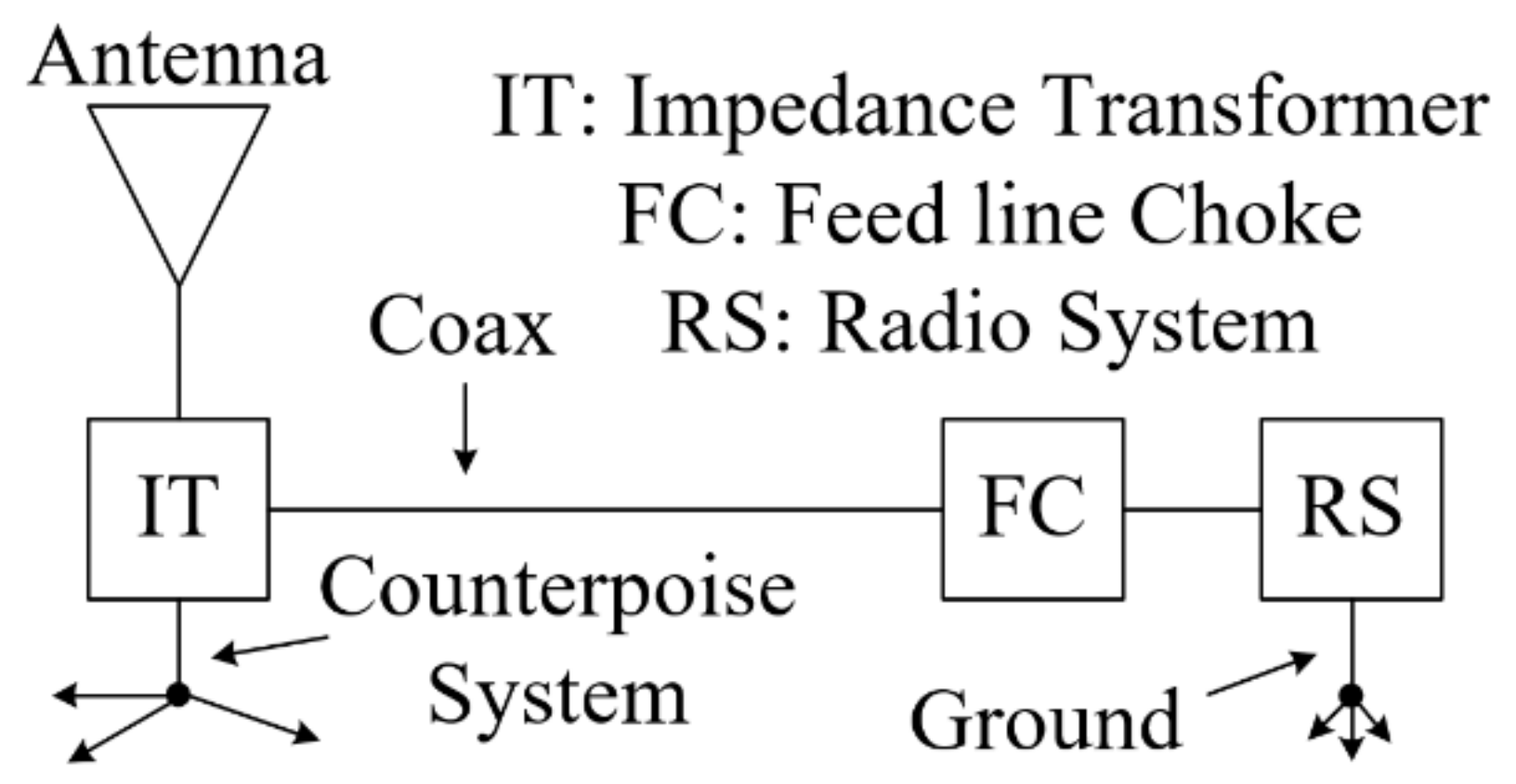


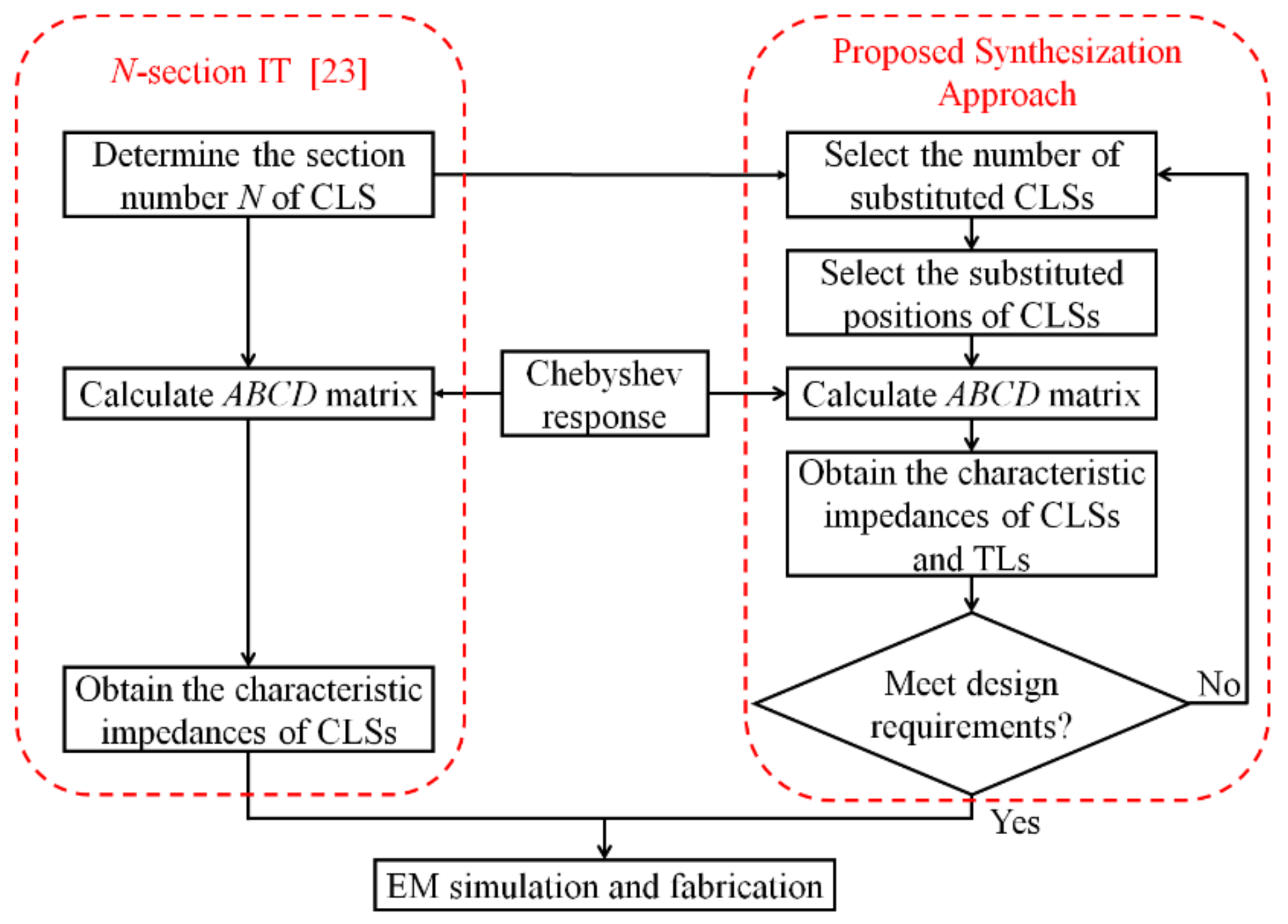


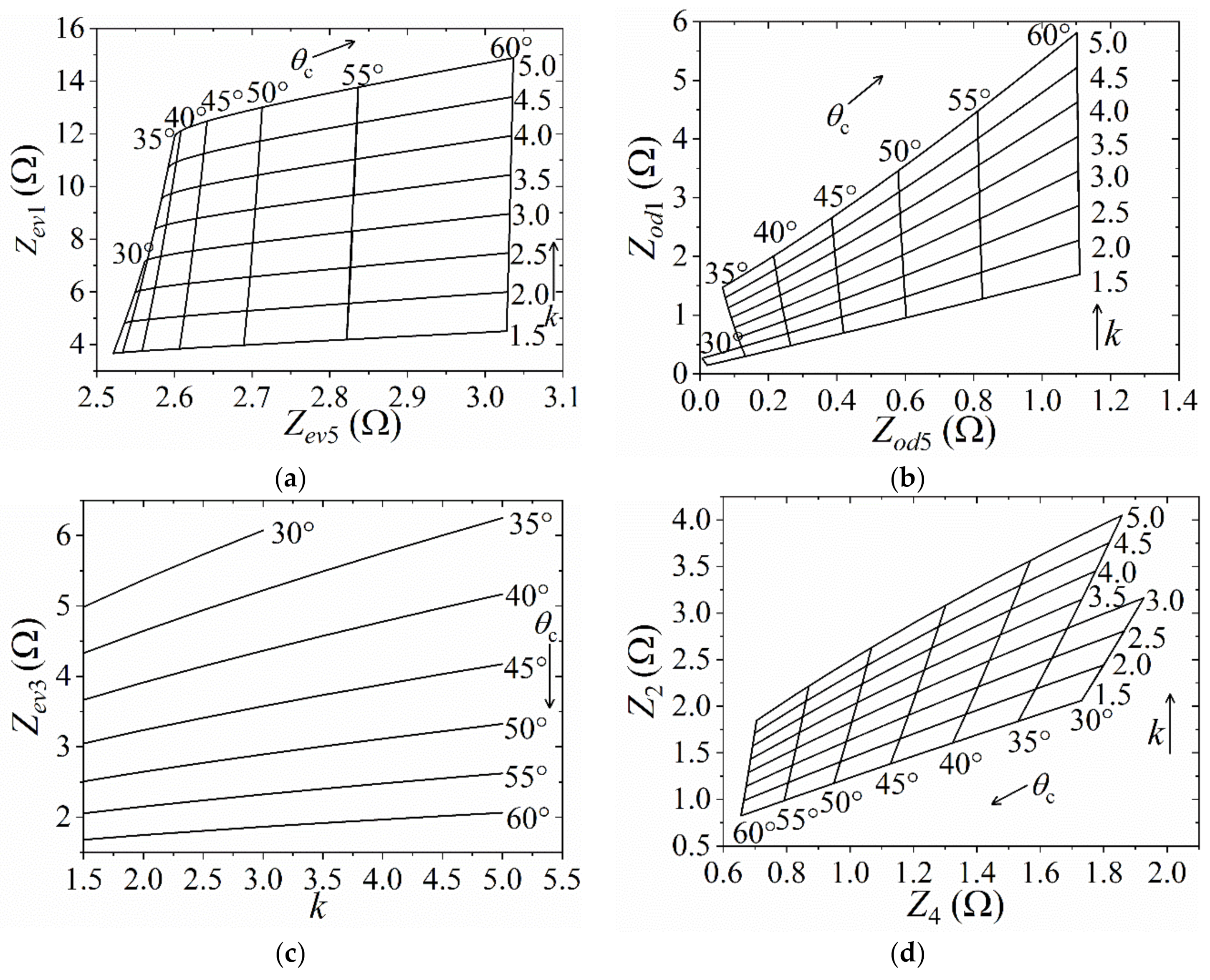

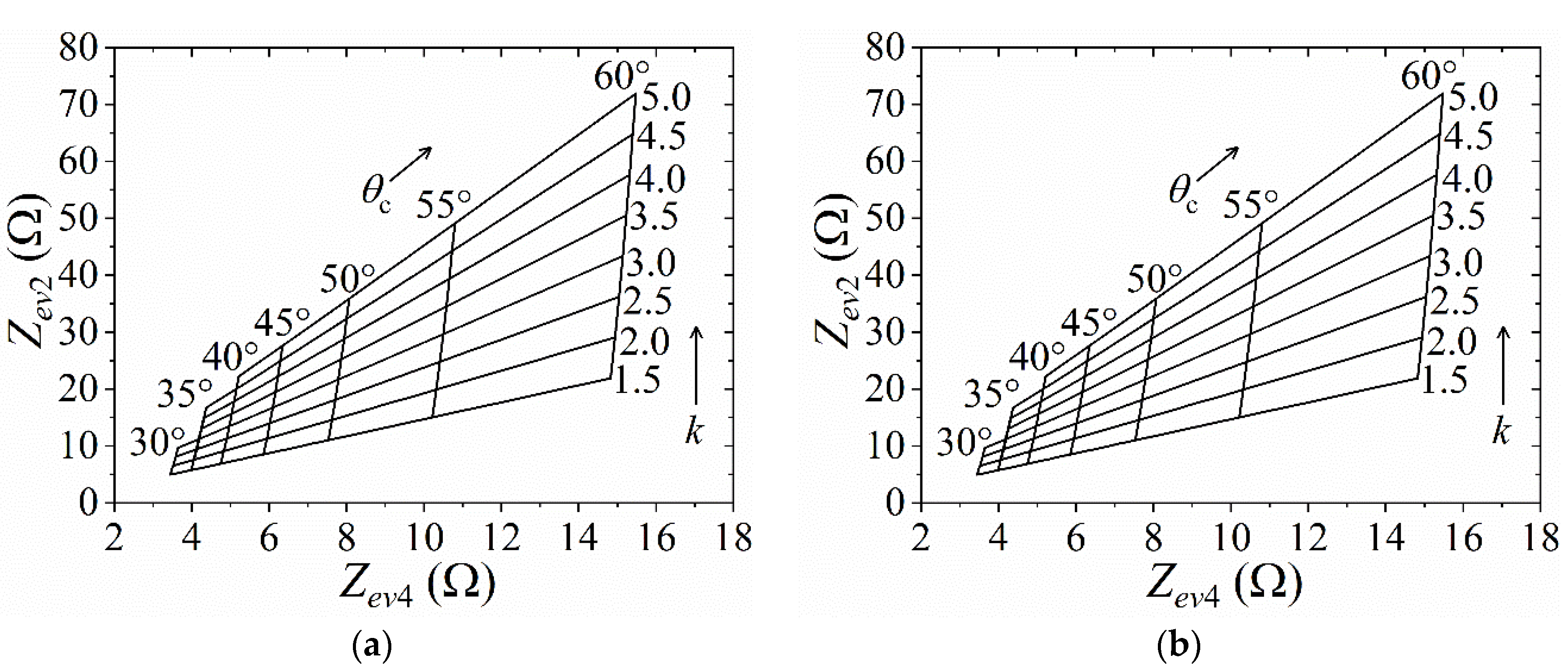
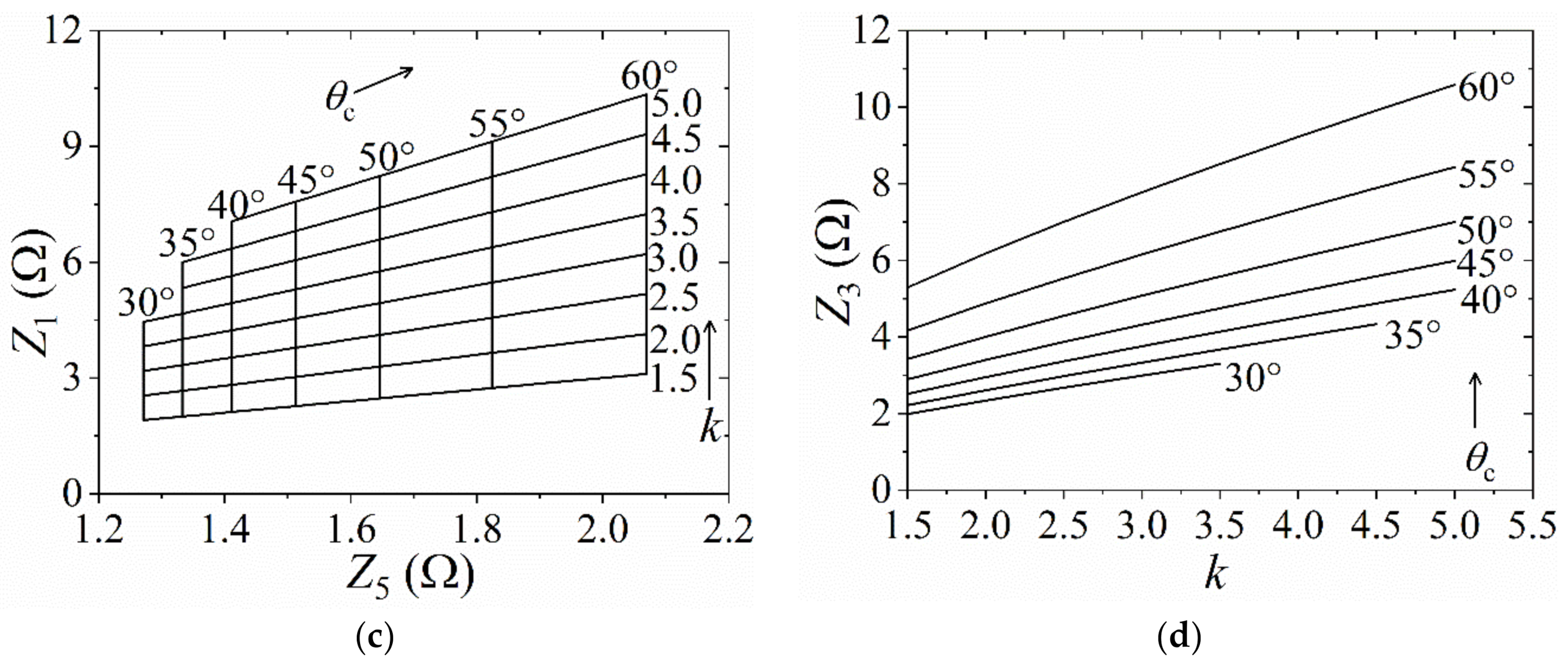
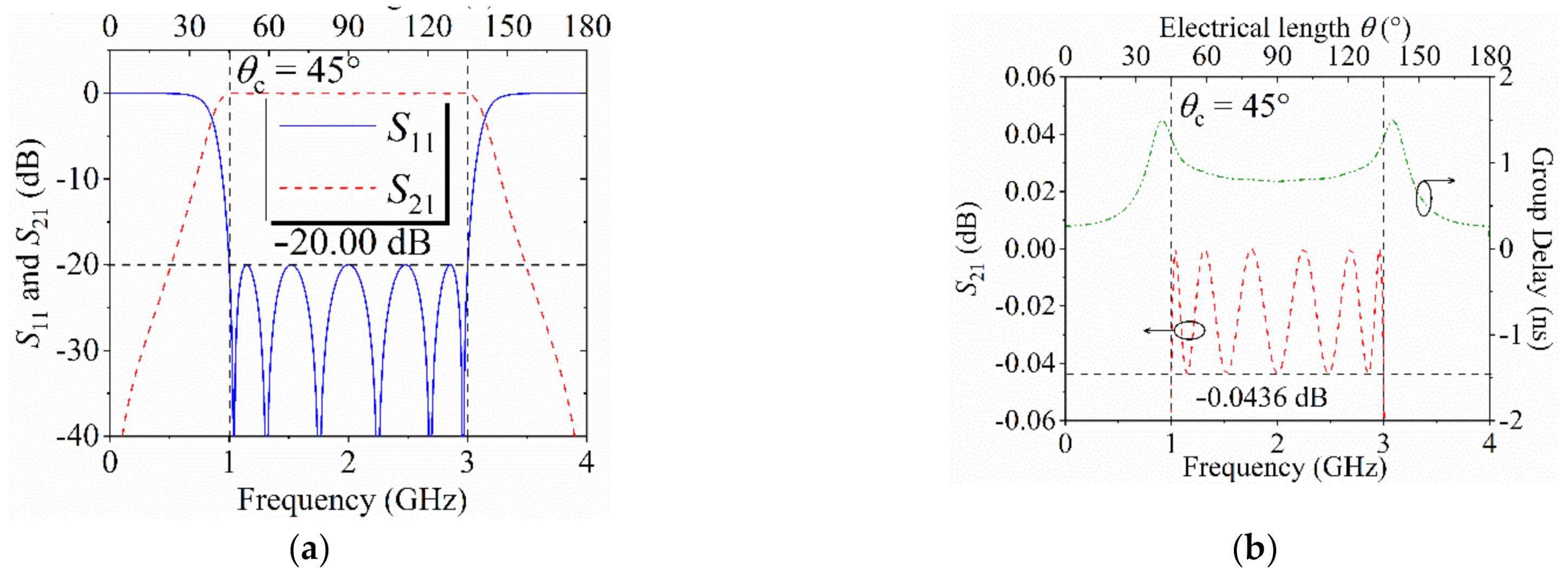
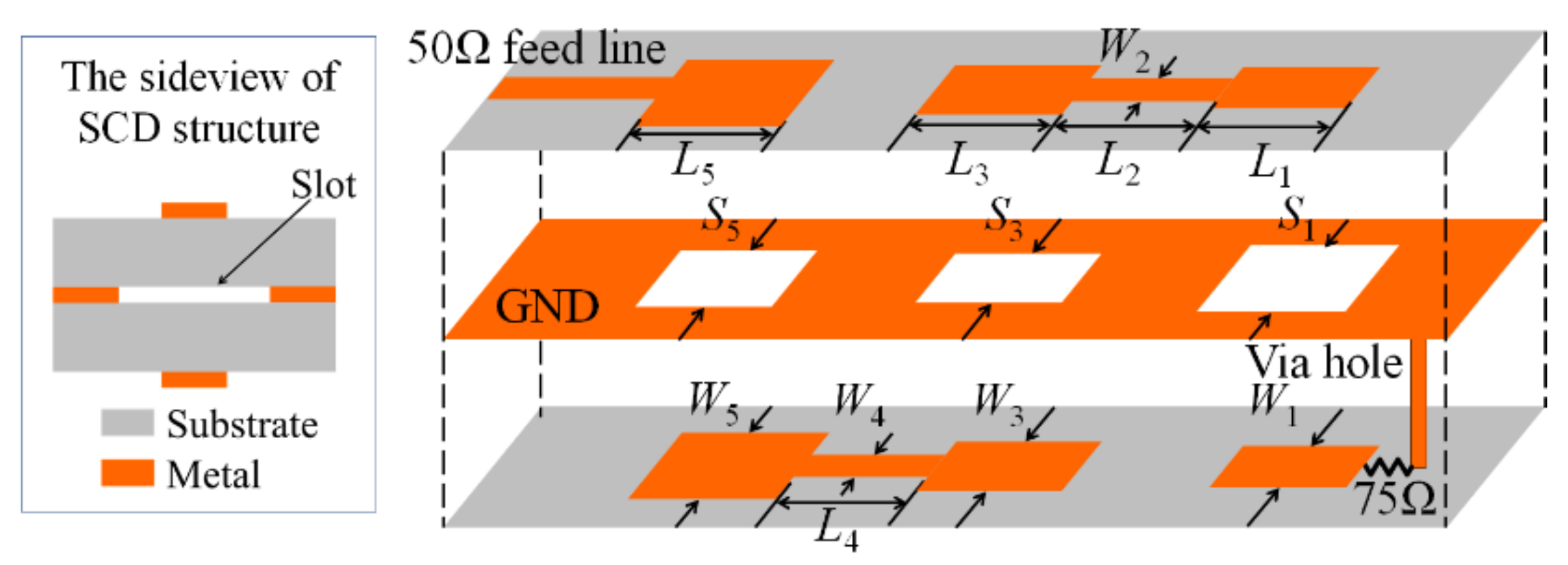

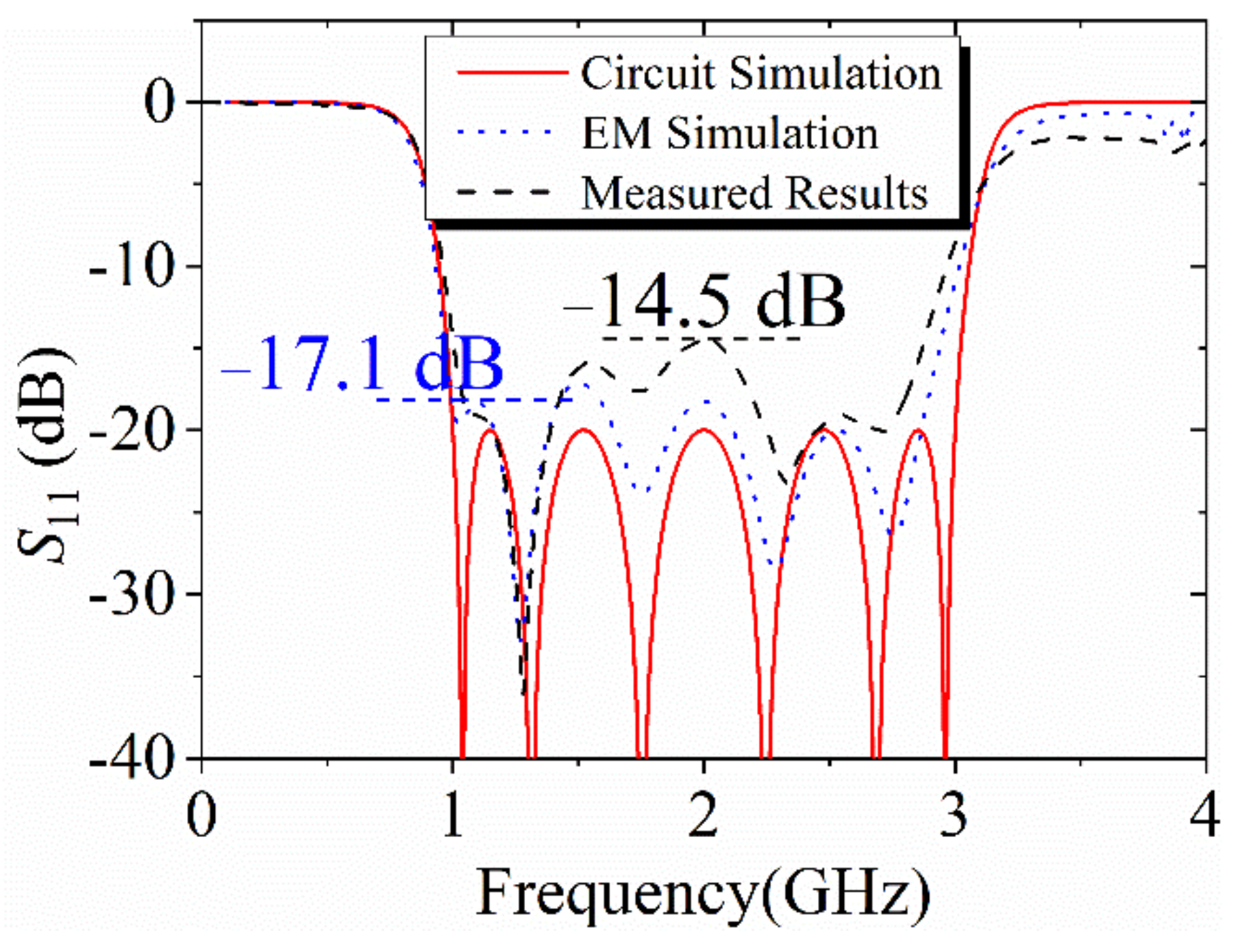
| Number of Substituted CLSs by TLs | Number of Substitutable Combinations |
|---|---|
| 1 | |
| 2 | |
| … | … |
| N − 3 | |
| N − 2 |
| The ith CLS Substituted By TL | 1st | 2nd | 3rd | 4th | 5th |
|---|---|---|---|---|---|
| Index of cases | Case 1 | Case 2 | Case 3 | Case 4 | Case 5 |
| The ith CLS Is Substituted by TL | ||||||
|---|---|---|---|---|---|---|
| The jth CLS is substituted by TL | 1st | 2nd | 3rd | 4th | 5th | |
| 1st | Case 6 | Case 7 | Case 8 | Case 9 | ||
| 2nd | Case 10 | Case 11 | Case 12 | |||
| 3rd | Case 13 | Case 14 | ||||
| 4th | Case 15 | |||||
| 5th | ||||||
| The ith CLS Is Not Substituted by TL | ||||||
|---|---|---|---|---|---|---|
| The jth CLS is Not substituted by TL | 1st | 2nd | 3rd | 4th | 5th | |
| 1st | Case 16 | Case 17 | Case 18 | Case 19 | ||
| 2nd | Case 20 | Case 21 | Case 22 | |||
| 3rd | Case 23 | Case 24 | ||||
| 4th | Case 25 | |||||
| 5th | ||||||
| Number of Variable Parameters | Substitutable Cases | Characteristic Impedances of theith CLSs or TLs (Ω) | Symmetrical/ Asymmetrical Topology | ||||
| 1st | 2nd | 3rd | 4th | 5th | |||
| 3 | Conventional topology [28] Former work | CLS Zev1 = 4.1030 Zod1 = 0.4371 | CLS Zev2 = 4.7546 Zod2 = 0.6000 | CLS Zev3 = 4.7474 Zod3 = 0.6000 | CLS Zev4 = 4.2000 Zod4 = 0.6000 | CLS Zev5 = 2.8441 Zod5 = 0.1826 | Symmetrical |
| 2 | Case 2 This work | CLS Zev1 = 3.8756 Zod1 = 0.6643 | TL Z2 = 1.5268 | CLS Zev3 = 3.8798 Zod3 = 0.6643 | CLS Zev4 = 3.9323 Zod4 = 0.6000 | CLS Zev5 = 2.8214 Zod5 = 0.2053 | Asymmetrical |
| 1 | Case 11 in Figure 5 This work | CLS Zev1 = 3.8447 Zod1 = 0.6953 | TL Z2 = 1.4813 | CLS Zev3 = 3.0487 Zod3 = 0.6000 | TL Z4 = 1.1271 | CLS Zev5 = 2.6067 Zod5 = 0.4200 | Symmetrical |
| Case 10 This work | CLS Zev1 = 3.7642 Zod1 = 0.7758 | TL Z2 = 1.1076 | TL Z3 = 0.9148 | CLS Zev4 = 3.0366 Zod4 = 0.6000 | CLS Zev5 = 2.7415 Zod5 = 0.2852 | Asymmetrical | |
| 0 | Case 18 This work | CLS Zev1 = 3.8158 Zod1 = 0.7242 | TL Z2 = 1.2486 | TL Z3 = 1.4696 | CLS Zev4 = 5.5788 Zod4 = 1.5118 | TL Z5 = 1.5133 | Asymmetrical |
| Case 19 [30] Former work | CLS Zev1 = 3.7113 Zod1 = 0.8287 | TL Z2 = 0.7888 | TL Z3 = 0.4592 | TL Z4 = 0.6071 | CLS Zev5 = 2.4931 Zod5 = 0.5336 | Symmetrical | |
| Case 21 in Figure 7 This work | TL Z1 = 2.2700 | CLS Zev2 = 8.5051 Zod2 = 2.1307 | TL Z3 = 2.8948 | CLS Zev4 = 5.8497 Zod4 = 1.2408 | TL Z5 = 1.5133 | Symmetrical | |
| Characteristic Impedance (Ω) | Coupling Strength (dB) | Physical Parameters (mm) |
|---|---|---|
| Zev1 = 192.23 Zod1 = 34.77 | 3.18 | W1 = 4.0 L1 = 27.5 S1 = 10.8 |
| Z2 = 69.06 | W2 = 1.4 L2 = 27.0 | |
| Zev3 = 152.43 Zod3 = 30.00 | 3.46 | W3 = 4.9 L3 = 26.7 S3 = 8.4 |
| Z4 = 56.35 | W4 = 2.1 L4 = 26.0 | |
| Zev5 = 130.33 Zod5 = 20.10 | 2.82 | W5 = 7.6 L5 = 26.4 S5 = 10.3 |
Publisher’s Note: MDPI stays neutral with regard to jurisdictional claims in published maps and institutional affiliations. |
© 2022 by the authors. Licensee MDPI, Basel, Switzerland. This article is an open access article distributed under the terms and conditions of the Creative Commons Attribution (CC BY) license (https://creativecommons.org/licenses/by/4.0/).
Share and Cite
Zhang, N.; Wang, X.; Bao, C.; Wu, B.; Chen, C.-P.; Ma, Z.; Lu, G. A Novel Synthetization Approach for Multi Coupled Line Section Impedance Transformers in Wideband Applications. Appl. Sci. 2022, 12, 875. https://doi.org/10.3390/app12020875
Zhang N, Wang X, Bao C, Wu B, Chen C-P, Ma Z, Lu G. A Novel Synthetization Approach for Multi Coupled Line Section Impedance Transformers in Wideband Applications. Applied Sciences. 2022; 12(2):875. https://doi.org/10.3390/app12020875
Chicago/Turabian StyleZhang, Nan, Xiaolong Wang, Chunxi Bao, Bin Wu, Chun-Ping Chen, Zhewang Ma, and Geyu Lu. 2022. "A Novel Synthetization Approach for Multi Coupled Line Section Impedance Transformers in Wideband Applications" Applied Sciences 12, no. 2: 875. https://doi.org/10.3390/app12020875
APA StyleZhang, N., Wang, X., Bao, C., Wu, B., Chen, C.-P., Ma, Z., & Lu, G. (2022). A Novel Synthetization Approach for Multi Coupled Line Section Impedance Transformers in Wideband Applications. Applied Sciences, 12(2), 875. https://doi.org/10.3390/app12020875






